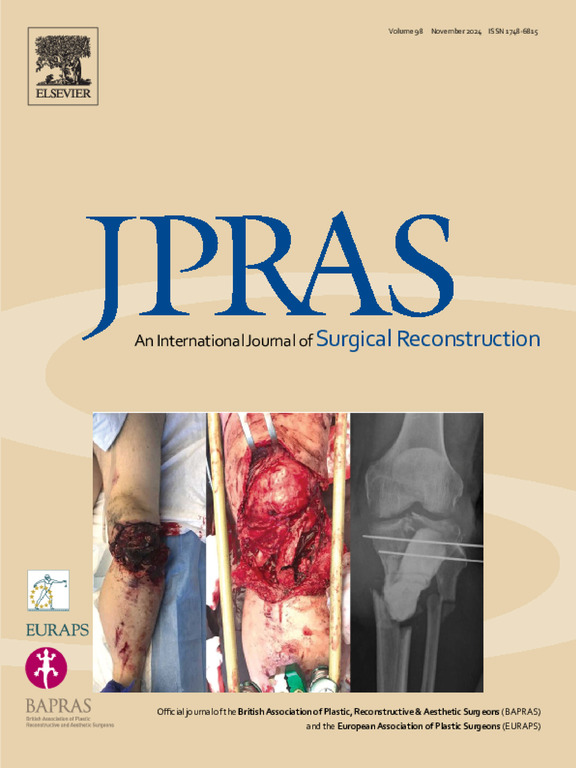骨骼肌减少症对自体乳房再造术术后并发症的影响:一项系统回顾和荟萃分析
IF 2.4
3区 医学
Q2 SURGERY
Journal of Plastic Reconstructive and Aesthetic Surgery
Pub Date : 2025-08-11
DOI:10.1016/j.bjps.2025.08.002
引用次数: 0
摘要
目的肌少症是指肌肉量减少并伴有肌肉功能丧失,已被证明可以预测一系列外科手术的术后并发症。骨骼肌减少症对自体乳房重建(ABR)后患者预后的影响尚不清楚。本系统综述和荟萃分析旨在评估肌肉减少症对ABR术后并发症的影响。方法结合PRISMA指南对电子数据库进行系统评价。研究报告了自体乳房重建术中肌少症与非肌少症患者的术后并发症。在所有纳入的研究中,通过客观测量计算机断层扫描(CT)上的腰肌指数(PMI)或骨骼肌指数(SMI)来确定肌肉减少症。结果本荟萃分析纳入了6项研究,报告了1315例乳房切除术后行ABR的患者的结果(407:908,肌肉减少:非肌肉减少)。骨骼肌减少患者血肿形成的风险增加(OR= 1.84, 95% CI= 1.06-3.18, p=0.03),但这与血肿复发风险增加无关(OR=1.11, 95% CI= 0.36-3.38, p=0.86)。肌少症患者与非肌少症患者ABR术后皮瓣缺损风险、受区感染风险、受区血肿形成风险、供区并发症风险、再手术风险或创面裂开风险差异无统计学意义。结论:自体乳房重建术患者血肿风险较高。需要前瞻性研究报告BMI、PMI/SMI、x线片肌肉衰减和患者报告的功能恢复情况,以全面评估肌肉减少症对乳房切除术后自体乳房重建的潜在影响。本文章由计算机程序翻译,如有差异,请以英文原文为准。
The effect of sarcopenia on postoperative complications in autologous breast reconstruction: A systematic review and meta-analysis
Purpose
Sarcopenia refers to a loss of muscle mass combined with an associated loss of muscle function and has been demonstrated to predict post operative complications across a range of surgical procedures. The effect of sarcopenia on patient outcomes following autologous breast reconstruction (ABR) remains unknown. This systematic review and meta-analysis aims to assess the impact of sarcopenia on complications following ABR.
Methods
A systematic review of electronic databases was performed in conjunction with PRISMA guidelines. Studies reporting on postoperative complications in sarcopenic versus non-sarcopenic patients undergoing autologous breast reconstruction were included. Sarcopenia was identified in all included studies by objectively measuring psoas muscle index (PMI) or skeletal muscle index (SMI) on computed tomography (CT) scan.
Results
Six studies were included in this meta-analysis, which reported outcomes of 1315 patients undergoing ABR following mastectomy (407:908, Sarcopenic: Non-Sarcopenic). Sarcopenic patients had an increased risk of haematoma formation (OR= 1.84, 95% CI=1.06–3.18, p=0.03), but this was not associated with an increased risk of return to theatre due to haematoma (OR=1.11, 95% CI=0.36–3.38, p=0.86). There was no significant difference in risk of total flap loss, recipient site infection, recipient site seroma formation, donor site complications, risk of re-operation or wound dehiscence between sarcopenic and non-sarcopenic patients following ABR.
Conclusion
This study reports a higher haematoma risk in sarcopenic patients undergoing autologous breast reconstruction. Prospective studies reporting on BMI, PMI/SMI, radiographic muscle attenuation, and patient-reported return to function are required to comprehensively evaluate the potential impact of sarcopenia on post-mastectomy autologous breast reconstruction.
求助全文
通过发布文献求助,成功后即可免费获取论文全文。
去求助
来源期刊
CiteScore
3.10
自引率
11.10%
发文量
578
审稿时长
3.5 months
期刊介绍:
JPRAS An International Journal of Surgical Reconstruction is one of the world''s leading international journals, covering all the reconstructive and aesthetic aspects of plastic surgery.
The journal presents the latest surgical procedures with audit and outcome studies of new and established techniques in plastic surgery including: cleft lip and palate and other heads and neck surgery, hand surgery, lower limb trauma, burns, skin cancer, breast surgery and aesthetic surgery.

 求助内容:
求助内容: 应助结果提醒方式:
应助结果提醒方式:


